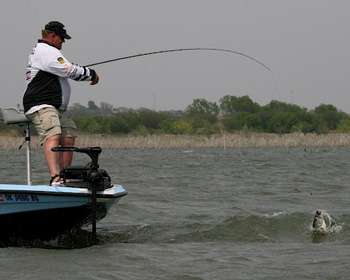
In all their tinkering with tackle, you'd think that by now the Elite Series pros would have come up with a magic number of rods that's optimum for any given tournament day. Is it an even 10? A dirty dozen? Unlucky 13?
Oklahoma pro Kenyon Hill says that the right number depends not only on the conditions at hand, but also on the particular angler.
"Everybody has a comfort zone," he says. "I know some tour guys who carry half a dozen rods with them. I carry 20 or 30 with me. You have to go with your own personality. If you feel good with 12 rods, take 12 rods. If 20 rods makes your rod box feel cluttered, don't take 20 rods. I don't think there's a right or wrong answer."
So how should the weekend angler answer the question after watching The Bassmasters and seeing Mike Iaconelli with a front deck literally covered in rods? Again, Hill said you can't fish like anyone else. It's all about personal style.
"Iaconelli is obviously tuned in to having lots of different baits and picking up a rod and making two or three or four casts with it, or maybe not fishing that rod all day because he didn't run across that situation," Hill opined. "That's why all those rods are out."
Hill may have as many rods in the boat as Ike, but often times he'll have a basic selection rigged up and ready to go and half of the total or more, with nothing tied on, just spooled up and ready to go should inspiration strike him.
When he's keyed into a particular bite or technique, he'll have multiple rods ready to go in order to maximize his efficiency: "I might have two of the same bait tied on different rods, especially if it's a soft plastic bait or something that can tear up," he said. "If I'm flipping a lot, I might have three flipping sticks out, two with a jig and one with a soft plastic as a change-up."
But among his two dozen or so rods, don't expect to see two dozen different models.
"I like to have a lot of redundant rods in case one breaks, or the line breaks, or I'm throwing a couple of different kinds of crankbaits or spinnerbaits. I try to keep it simple in the types of rods I have — but I have a lot of them.
The goal is to find particular models that can be used for multiple applications: "I like rods that I can do a number of things with," he said. "For instance, American Rodsmiths makes one called a Redfish Hammer Elite. It's a medium action 7-foot rod and it's a wonderful rod for crankbaits, spinnerbaits, jerkbaits and topwaters. I throw all that on that one rod. I have five or six of them. They all have the same Revo reels — but with different gear ratios.
"I like to have something I can throw a jig or a Carolina rig with. I also have a spinning rod. It's a very good piece of equipment and a lot of people don't utilize it. Especially with the new superlines (especially braids), you can tie in fluorocarbon leaders of 6- to 12-pound test and use many different kinds of baits, all the way from a drop shot on 6-pound test to a Fluke in heavy cover.
Finally, he keeps handy a heavy flipping/pitching rod for when bass are hiding in thick cover.
Your magic number may not be the same as Hill's. In fact, both of you may have a different magic number or the same one on any given day, but the key is to make sure you have all of your bases covered and a contingency plan — and that you're comfortable with your chosen number of rods.





